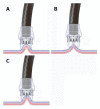Outcomes of gastrointestinal defect closure with an over-the-scope clip system in a multicenter experience: An analysis of a successful suction method
- PMID: 28321166
- PMCID: PMC5340817
- DOI: 10.3748/wjg.v23.i9.1645
Outcomes of gastrointestinal defect closure with an over-the-scope clip system in a multicenter experience: An analysis of a successful suction method
Abstract
Aim: To demonstrate the clinical outcomes of a multicenter experience and to suggest guidelines for choosing a suction method.
Methods: This retrospective study at 5 medical centers involved 58 consecutive patients undergoing over-the-scope clips (OTSCs) placement. The overall rates of technical success (TSR), clinical success (CSR), complications, and procedure time were analyzed as major outcomes. Subsequently, 56 patients, excluding two cases that used the Anchor device, were divided into two groups: 14 cases of simple suction (SS-group) and 42 cases using the Twin Grasper (TG-group). Secondary evaluation was performed to clarify the predictors of OTSC success.
Results: The TSR, CSR, complication rate, and median procedure time were 89.7%, 84.5%, 1.8%, and 8 (range 1-36) min, respectively, demonstrating good outcomes. However, significant differences were observed between the two groups in terms of the mean procedure time (5.9 min vs 14.1 min). The CSR of the SS- and TG-groups among cases with a maximum defect size ≤ 10 mm and immediate or acute refractory bleeding was 100%, which suggests that SS is a better method than TG in terms of time efficacy. The CSR in the SS-group (78.6%), despite the technical success of the SS method (TSR, 100%), tended to decrease due to delayed leakage compared to that in the TG-group (TSR, CSR; 88.1%), indicating that TG may be desirable for leaks and fistulae with defects of the entire layer.
Conclusion: OTSC system is a safe and effective therapeutic option for gastrointestinal defects. Individualized selection of the suction method based on particular clinical conditions may contribute to the improvement of OTSC success.
Keywords: Endoscopic closure; Fistula; Gastrointestinal refractory bleeding; Leak; Over-the-scope clip.
Conflict of interest statement
Conflict-of-interest statement: The authors have no conflicts of interest to report.
Figures






References
-
- Schecter WP, Hirshberg A, Chang DS, Harris HW, Napolitano LM, Wexner SD, Dudrick SJ. Enteric fistulas: principles of management. J Am Coll Surg. 2009;209:484–491. - PubMed
-
- Gotoda T, Yamamoto H, Soetikno RM. Endoscopic submucosal dissection of early gastric cancer. J Gastroenterol. 2006;41:929–942. - PubMed
-
- Mori H, Kobara H, Kobayashi M, Muramatsu A, Nomura T, Hagiike M, Izuishi K, Suzuki Y, Masaki T. Establishment of pure NOTES procedure using a conventional flexible endoscope: review of six cases of gastric gastrointestinal stromal tumors. Endoscopy. 2011;43:631–634. - PubMed
-
- Jirapinyo P, Watson RR, Thompson CC. Use of a novel endoscopic suturing device to treat recalcitrant marginal ulceration (with video) Gastrointest Endosc. 2012;76:435–439. - PubMed
-
- Mori H, Kobara H, Kazi R, Fujihara S, Nishiyama N, Masaki T. Balloon-armed mechanical counter traction and double-armed bar suturing systems for pure endoscopic full-thickness resection. Gastroenterology. 2014;147:278–280.e1. - PubMed
Publication types
MeSH terms
LinkOut - more resources
Full Text Sources
Other Literature Sources
Medical
Miscellaneous

